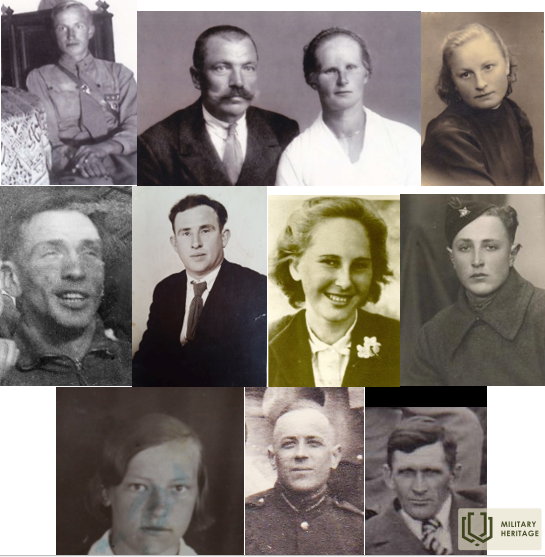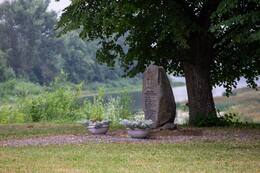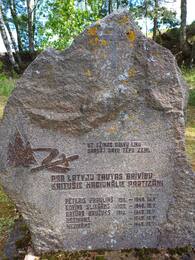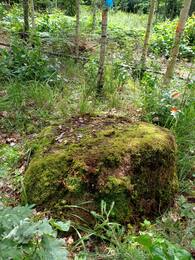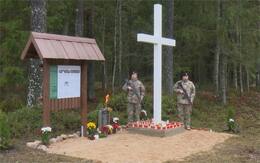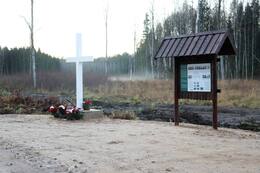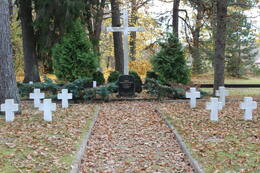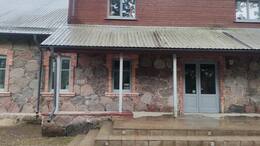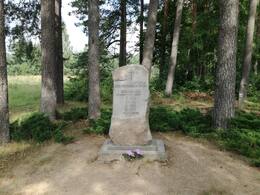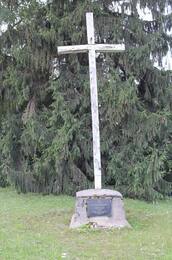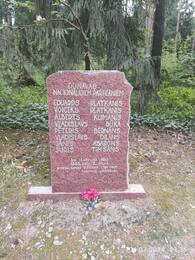Selija's forest brother settlement in the Sūpe swamp
The Sūpes swamp is associated with the sites of national partisan settlements and battles, which were formed through the interaction of people and places. It is described in the ballad of the exiled Latvian writer Alberts Eglītis about the events in his native Sūpes swamp “In Moss and Mud” - a tribute to the Sūpes swamp partisans:
… “In 1945, as autumn glowed in the swamp -
On Pokļevinskis' birthday, Lieljānis shares at dinner:
Beer fermented in willows,
The Romulans worship butter,
I dry my mother's caraway bread,
Dried ham in March cuts,
And Stuchka's onions,
Ildzeniece cheese.
Rooms in resinous walls
And lightning has struck hearts,
And in eleven souls languish-
"The roots that have rotted in the ground..."
This interpretation of the past, with its post-World War II events, included human testimonies, expressions of spirit, and value systems. It recalls the popular support for the national partisans, whom the occupying power could not defeat so easily.
After the deportations of the population on March 25, 1949, the national partisan supply system was destroyed. From the summer of 1949 to mid-1952, the Sēlija national partisan resistance movement in the areas of Aknīste, Birži, Elkšņu Gārsene, Sauka, Susēja and Viesīte was in decline. The defeat came from ethnic cleansing and from the regular actions of the army and security service.
The Indāns-Grāvelsons settlement, with such a serious defense system, did not exist anywhere else in Latvia in the 1950s, including Sēlija's southern border neighbor, Lithuania. The Indāns-Grāvelsons group bunker in the Elkšņu forest in the winter of 1949-1950 is characterized by a unique defensive fortress for that time. With specially created perimeter defense trenches and weapon nests. Family members could not be separated and responsibility for their safety was primarily taken on by men who had gained military experience, as well as the women themselves, who were not afraid to take up weapons. Their goal in case of danger was to repel the attacker. This special identity, which manifested itself in the final stages of the war, is characterized by the involvement of family members who escaped repression. It was also manifested in psychological preparation and the fatal outcome was no longer a surprise. The Indāns-Gravelsons group was well aware of its hopeless situation and was ready to fight to the death.
Indans-Gravelsons United National Partisan Group:
Group leader Jānis Indāns, Pēteris Indāns, Kristīne Indāne, Milda Ārija Indāne, Vasilijs Sokolovs, Jānis Ķepiņš, Hilda Vietniece, Artūrs Snikus, Alma Grāvelsone, Group leader Jānis Edvards Grāvelsons, Jonas Žukauskas.
Oral testimony
Partisan liaison officer Jānis Snikus : "Mārtiņš Pokļevinskis showed the common partisan grave and said that he had pulled my brother Artūrs Sniks out of the grave, placing him with his head facing north. Mārtiņš Pokļevinskis claimed that the partisans had given up their heads too cheaply, because they had only to leave the bunker when darkness fell, then break through. A wreath was placed on the common partisan grave. Together with Mārtiņš Pokļevinskis, we hastily buried the partisan Voldemārs Sātnieks, who had been abandoned in the forest unburied, digging as much as we could into the ground."
Vilma Birša (Saulīte): “In the spring of 1950, before the capture, we went to see the Indāns-Grāvelsons bunker with Mārtiņš Pokļevinskis, and we found a burial place for partisans, which was not far from the bunker. Pokļevinskis tried to turn the fallen over with a long stick for viewing, I clearly saw Indāns, Sniks, Artūras and Mildiņš, they were both holding each other, Artūras still had a ring on his hand. I couldn’t look any longer, because it was all unbearably heavy. Soldiers’ hats were thrown around in the place where the battle had taken place. You could see places where the troops had camouflaged themselves with spruce branches and waited for the partisans to leave the bunker.”
Jānis Plāns: "I worked at the Viesīte railway station on a train and on that date I was supposed to go to load timber at the 22nd kilometer of the Elkšņi branch. When we arrived at the 14th kilometer, we were stopped by an army order because the shooting had started." After the shooting, Jānis Plāns was given the order: "ложись" - to lie down. Jānis Plāns obeyed the order and lay down on the train platform. When the train passed the shooting area, he could see that soldiers in white camouflage were sleeping behind every tree. When he arrived at the 22nd kilometer, the shooting resumed even more intensely. "When we loaded the timber onto the train and went back, the shooting had stopped, but the entire forest was still surrounded." After these events in the summer month at the 14th kilometer, when they were loading timber together with the driver, Jānis Plāns went to see the scene. When he approached the bunker, he could see a small hillock, with small fir trees growing around it. The bunker had remained intact with all the trenches, when he entered the bunker it was empty, the ceiling was not high, but he could straighten his body. Inside the bunker, Jānis Plāns remembers that there was a table and opposite the entrance he could see lava on two floors. A sauna with a stone fireplace was located 10-15 meters from the bunker.
Hilda Miezīte (Vietniece): "The attack took place in the morning, it was still snowing lightly. It was a betrayal and it was, some kind of forester". Hilda Miezīte remembered that she could hear the roar of cars all around, reinforcements had arrived. Hilda does not understand how she stayed alive, because bullets came from all directions. In her opinion, the bunker was abandoned because they would not have been able to hold out, grenades were thrown and loudspeakers were blaring. The settlement would have been destroyed one way or another. Living in the forest conditions, no one was allowed to leave the settlement, strict discipline prevailed, nicknames also existed so as not to reveal their identity. The men regularly changed guard posts. The roof of the bunker was built continuously from logs, it was low with a slight elevation, covered with earth, sod and moss. On the entrance side, there was a slight elevation with a slight slope to the opposite side. A small window had been built to the right of the entrance door. There were beds in the bunker and a stove was in the middle. There were not many belongings or household items - some had only the clothes they were wearing. A gramophone with vinyl records played in the settlement rooms, which they listened to quietly from time to time.
Eglītis. Songs of the Cold Season: Lyrical Notes of a Journalist. [Minneapolis: Sēļzemnieks, 1983, p. 28]
Related timeline
Related topics
Related objects
Memorial stone to Rihards Pārups' national partisan group
Located on Riga Street near the Krustpils Lutheran Church.
On September 22, 1996, a memorial stone was unveiled in Krustpils to Rihards Pārups and the national partisan group he led. The memorial stone was created by sculptor Ilgvars Mozulāns, and its creation was financially supported by the Speaker of the Saeima, Ilga Kreituse. This event was organized by the board of the Latvian National Partisan Association.
To the national partisans of Rihards Pārup,
who were murdered by a Cheka special group
Richard Parups (1914 – 2nd July 1946)
Group commander
Richard Stulpins (1923 – 1946. 2. VII)
Alberts Avotiņš (1912 – 2 July 1946)
Erik Juhna (1928 - 2 July 1946)
Aleksandrs Lācis (1919 – 2 July 1946)
Peter the Bear (1921 – 1946, 2nd July)
Jānis Ēvalds Zālītis (Āboliņš) (1911 – 1946, 2nd July)
Siegfried Bimstein, Theodore Schmidt (… – 2 July 1946)
Uldis Šmits (... - 1946. 2. VII)
Peter Lazdans (1926 – 1947)
Erik Konval (1929 – 1947. VI)
Niklāss Ošiņš (1908 – 12 October 1954) – executed in Riga
Alberts ħiķauka (1911 – 1972 II) – imprisoned in the Mordovian camp
Rihards Pārups was born on June 11, 1914 in “Kaķīši” of Krustpils parish. During World War II, he was a sergeant of the anti-tank division of the 15th Latvian division. He participated in national partisan operations in the Jēkabpils and Madona areas and was a member of the National Resistance Movement, the leader of a unit in the Jēkabpils and Madona areas. Rihards Pārups fell in battle with Cheka troops on July 2, 1946 in Vietalva parish. Unfortunately, the place of burial is unknown. A memorial plaque has been installed in the Riga Brothers' Cemetery. In the autumn of 1945, a national partisan group was formed in Jēkabpils district, led by R. Pārups. During its short existence, it participated in more than twenty armed clashes with units of the then Ministry of the Interior. The report of the Cheka Colonel Kotov to the Riga leadership states that the activities of the Soviet government in the Jēkabpils and Madona districts were effectively paralyzed during this time as a result of the group's activities. The national partisans led by R. Pārup found and destroyed several lists of deportations, thus saving the lives of many people. The leadership of the Security Committee, unable to destroy the national partisan unit in open battle, infiltrated it with four people from the Cheka special group, who shot ten partisans of the unit, including R. Pārup. In 1947, two more were shot near Jaunkalsnava, and in 1951 — one member of this unit. After twenty-five years of hard labor in a Mordovian camp, the fourteenth partisan of the group led by R. Pārup died a few days before liberation.
Memorial site to the members of the P. Prauliņš national partisan group and the site of the bunker
Pēteris Prauliņš (1911-1949) Birži parish national partisan group was part of the group led by Mārtiņš Pokļevinskis (1902-1951). The group carried out several partisan actions, in which Soviet collaborators were punished and food and property of the economic institutions of the occupation authorities were requisitioned. P. Prauliņš's group partisans did not observe sufficient conspiracy, many persons visited their settlement, which created an opportunity for betrayal. The lack of military experience was one of the shortcomings of the partisan armed movement.
P. Prauliņš's partisan group in the Kalna forest in the Birži parish was destroyed on May 16, 1949, during an operation by the Ministry of State Security of the Latvian SSR, in which military units also participated. The forest brothers had set up a bunker with perimeter defense, which was well camouflaged and was located at an undetermined height in a swampy area. The partisans fiercely resisted the Cheka troops for at least 40 minutes, but the entire group fell: Pēteris Prauliņš, Artūrs Bružuks, Jānis Kalvāns, Edvīns Slikšāns and Francis Skromanis. The shot forest brothers were thrown near the parish house, but their remains were later buried in nearby gravel pits. Irma Bružuka was seriously wounded, who was captured and died on May 17 in Jēkabpils Hospital. She was buried outside the cemetery, but when the cemetery was expanded after Latvia regained its independence, a monument was placed on her grave.
A memorial stone to the partisans of P. Prauliņš' group in Kalna parish was consecrated in November 1998. The site of P. Prauliņš' bunker is located in section 4 of Vidsala 99th block, Kalna parish. The stone on which P. Prauliņš sat has been preserved.
P. Prauliņš's national partisan group bunker site
The site of P. Prauliņš' bunker is located in the 4th section of Vidsala block 99, Kalna parish. The stone on which P. Prauliņš sat has been preserved.
P. Prauliņš's (1911-1949) partisan group in the Kalna forest in the Birži parish was destroyed on May 16, 1949, during an operation by the Ministry of State Security of the Latvian SSR, in which military units also participated. The forest brothers had set up a bunker with perimeter defense, which was well camouflaged and was located at an undetermined height in a swampy area. The partisans fiercely resisted the Cheka troops for at least 40 minutes, but the entire group fell: Pēteris Prauliņš, Artūrs Bružuks, Jānis Kalvāns, Edvīns Slikšāns and Francis Skromanis. The shot forest brothers were thrown near the parish house, but their remains were later buried in nearby gravel pits. Irma Bružuka was seriously injured, who was taken prisoner and died on May 17 in Jēkabpils Hospital. She was buried outside the cemetery, but when the cemetery was expanded after Latvia regained its independence, a monument was placed on her grave.
The Birži parish national partisan group of Pēteris Prauliņš was part of the group led by Mārtiņš Pokļevinskis (1902-1951). The group carried out several partisan actions, in which Soviet collaborators were punished and food and property of the economic institutions of the occupation authorities were requisitioned. The partisans of P. Prauliņš' group did not observe sufficient conspiracy, many persons visited their settlement, which created an opportunity for betrayal. The lack of military experience was one of the shortcomings of the partisan armed movement.
A memorial stone to the partisans of P. Prauliņš' group in Kalna parish was consecrated in November 1998.
Memorial site to the members of the J. Indāns - J. Grāvelsons and M. Pokļevinskis national partisan groups
An information stand and memorial site for the Indāns - Grāvelsons national partisan group in Kalna parish, Jēkabpils region, in the vicinity of Sūpes purvas, was opened on Lāčplēsis Day - November 11, 2019. Representatives of Jēkabpils region and Viesīte region, former national partisan H. Miezīte, historian H. Bruņinieks, as well as guests from Lithuania and other interested parties participated in its opening. The memorial site and stand are located near Sūpes purvas, which is associated with the sites of national partisan settlements and battles. Deeper in the forest was also the bunker of the Indāns-Grāvelsons group.
After the deportations of the Latvian population on March 25, 1949, the national partisan supply system was destroyed. From the summer of 1949 to mid-1952, the national partisan movement in the Aknīste, Sauka, Elkšņi, Birži and Viesīte areas experienced its decline, as it suffered from ethnic cleansing and regular counterattacks by the Soviet army and security institutions. The settlement of the national partisan group of Jānis Indāns and Jānis Grāvelsons in the Elkšņi forest in the winter of 1949-1950 had a very serious defense system, uncharacteristic for that time, which did not exist anywhere else in Latvia or in its neighboring country Lithuania in the 1950s. The bunker of the Indāns-Grāvelsons group had specially created perimeter defense trenches and gun nests. Along with the partisans' military readiness to sacrifice their lives in the fight against the enemy, it is also possible to speak of their special identity, which was also manifested in the involvement of other family members in the ranks of the national partisans.
The Indāns-Grāvelsons joint partisan group consisted of 12 people, including five women and one Lithuanian partisan: Jānis Indāns, Jānis Edvards Grāvelsons, Alma Grāvelsone, Pēteris Indāns, Kristīne Indāne, Milda Ārija Indāne, Vasilijs Sokolovs, Voldemārs Otto Sātnieks, Jānis Ķepiņš, Hilda Vietniece, Artūrs Snikus, Jons Žukauskis. Their last battle took place on February 25, 1950, in the Elkšņu Forest, when 11 partisans fell in battle against disproportionately strong forces. Only Hilda Vietniece (Miezīte) survived, who was captured and later spent six years in prison in the Gulag camps.
Memorial site at the site of the national partisan battle of February 13, 1945 in the Diamond Forest of Kalna Parish
The memorial site was created on the regional road P74 Siliņi - Aknīste, 12 kilometers from Aknīste, turning onto the Latvian State Forest "Žagari ceļa".
The vast forest massif of the northern part of Elkšķi parish already at the end of the summer of 1944 became a gathering place for people who were preparing for armed struggle against the Soviet occupation power. At the end of 1944, national partisan groups began to form in the Aknīste area. A suitable place for establishing a partisan camp was the Diamond Forest , which was located on the southern edge of the Elkšķi large forest, near the Aknīste Great Swamp. There, less than 10 kilometers from Aknīste parish, the national partisans created three winter bunkers for wintering. Communications of the men gathered in the forest were ensured with the support of nearby houses - Baltimores, Gargrodes, Līči, Priedes, Krūmi and residents of other houses, neighbors and partisans.
The partisan battle with the soldiers of the Latvian SSR Ministry of State Security in the Diamond Forest took place on February 13, 1945. The Chekists, having taken hostages, drove them forward to reveal the partisan bunkers. The Forest Brothers, seeing the danger, opened fire, not sparing the hostages. 10 representatives of the Soviet occupation troops, eight national partisans and four hostages fell in the battle. Despite the losses of the Forest Brothers, the Chekists failed to capture the partisan bunkers. The surviving partisans waited for darkness and left the settlement. The Chekist soldiers wounded in the battle, groaning, were unable to leave the battlefield. After this battle, which can be considered the forest brothers' first "baptism of battle", the partisans felt like brothers and the rifle seemed more precious than anything, like the only reliable savior.
The White Cross and information stand in the Diamond Forest were installed on Lāčplēsis Day - November 11, 2022. The creation of the memorial site was supported by the Jēkabpils regional government, the association "Tēvzemes sargi" and the Latvian State Forests. The author of the content of the information stand is historian Haralds Bruņinieks.
Cemeteries of the National Partisans of Sēlia
The Sēlija National Partisan Brothers Cemetery was opened on October 30, 2004 with the support of the Latvian Ministry of Defence and the Aknīste Municipality. The partisans who fell in the battle of December 19, 1949 in the Dimantu Forest of Kalna Parish are buried there: Alberts Karankevičs (1914-1949), Vilis Tunķels (1911-1949), Arnolds Tunķels (1926-1949), Osvalds Tunķels (1929-1949), Ēvalds Kundzāns (1927-1949).
In 2005, the partisans who fell in the battle of February 13, 1945 in the Elkšņi Forest were also reburied here: Juris Alfreds Voldemārs Lācis (1908-1945), Eduards Kaminskis (1910-1945), Osvalds Mežaraups (1911-1945), Alberts Mežaraups (1915-1945), Antons Bružiks (1911-1945), Jānis Britāns (1926-1945) and one unknown. The common cemetery also contains the remains of Marta Mežaraupe (1907-1945), Alberts Lācis (1902-1945), Juris Resnītis (1901-1945) and Pēteris Bite (1907-1945), who were taken hostage by the Soviet occupation authorities and fell during the battle, as well as Voldemārs Otto Sātnieks (1911-1950), a fallen partisan of the Indāns-Grāvelsons group. The Aknīste Brothers' Cemetery also houses a monument to Alfreds Silaraup (1925-1946), a national partisan of the Aknīste Company, who fell during a Cheka operation on July 30, 1946, on the narrow-gauge railway in the Elkšņu Forest.
At the foot of the White Cross erected at the Brothers' Cemetery of the National Partisans of Sēlija, a black granite stele with the emblem of the Latvian National Partisan Association and the text engraved below it, "To the National Partisans of Sēlija. You sacrificed your lives for Latvia in the fight against the communist occupation regime in 1944-1954." There is also a memorial stone in the cemetery with the inscription "There are tears that will be shed in silence. There are scars that will not heal when healed," which was erected by Stanislava Šadurska at the beginning of the Awakening near the pit where the Chekists buried the national partisans and hostages who had fallen the day before on February 14, 1955.
Former Susēja parish house, site of attack by national partisans on July 7, 1945
Today, the former Susėja parish house houses the Sanssouci residence center. The facade of the building still bears traces of the attack left by bullets fired by national partisans during the attack on July 7, 1945.
The former Susēja parish house, which at that time functioned as the local executive committee of the Soviet occupation authorities, suffered an attack by the Sēlija national partisans on July 7, 1945. The attack on the Susēja executive committee was part of a wider national partisan campaign and took place simultaneously with the attacks on the Vilkupe butter factory and the house of the destroyer Kaunackas.
According to the instructions of the commander of the Susėja national partisan group, Albert Kaminskis (1920-1946), the Forest Brothers were to destroy the security of the local executive committee, take weapons, militia uniforms, documents and damage telephone communications. About 17 Forest Brothers under the leadership of the Lithuanian partisan commander Jozas Kuveikis participated in the attack on the Susėja executive committee. The battle lasted 15-20 minutes, one Lithuanian partisan fell during the firefight, and on the other side - a fighter of the destroyer battalion Jānis Kakarāns. During the firefight, the windows of the executive committee were broken and the telephone was damaged.
The second attack on the Susēja Executive Committee took place on July 16, 1945, when a prolonged firefight took place between the Forest Brothers and fighters of the destroyer battalion who had sought refuge in the Executive Committee building. During the battle, a group of Soviet soldiers came to the aid of the latter, who opened machine-gun fire from the flank and forced the partisans to retreat. At least five Forest Brothers and five destroyers fell in the battle. The attacks on this administrative object of the occupation power confirmed the nature of the armed resistance of the partisan war and were a warning about the people's resistance to the Soviet occupation power.
Monument to the National Partisans of Susėja
The Susēja national partisan unit was formed from smaller fragmented forest brotherhood groups, because initially there was no leader who could unite them. For a short time, Artūrs Grābeklis tried to coordinate the activities of the Susēja partisans, and later Markejs Gorovņovs, who fell in the winter of 1945. The Susēja national partisan unit was strengthened after the former legionnaire Alberts Kaminskis arrived in Courland, Sēlija, after the general capitulation of Germany. He established stricter discipline and united smaller groups for a joint fight against the Soviet occupation power. Cooperation was also established with forest brotherhood groups from nearby parishes and areas, especially with the Gārsene group and Lithuanian partisans who had settled on the border of Lithuania and Latvia.
In the early stages of the armed movement, it is clear that the Forest Brothers were not prepared for attacks, unable to occupy either the Kaunacki farmstead or break into the building of the Susėja executive committee. The partisans suffered losses and were unable to resist the Cheka troops for a long time, and the main method of fighting was to think about retreating in time. There was also a problem with the supply of the partisans. Despite the existing difficulties, the Susėja national partisan unit was still able to actively resist the Soviet occupation power in the first post-war years. This partisan group ceased to exist after the fall of its commander A. Kaminskis on May 14, 1946. This was also followed by the legalization of several Forest Brothers, as well as joining other partisan groups.
The monument to the national partisans of the Susēja company was opened on November 11, 1997, at the initiative of Gunārs Blūzmas, a researcher of the history of the national partisans of Sēlija. Next to the names of the fallen Susēja national partisans, a text is carved into a roughly worked boulder under the sign of a cross: “On the head of a hedgehog, I ordered you to protect your father’s land.” The monument mentions those who fell in the attack on the Susēja executive committee on July 16, 1945 - Jānis Grābeklis (1923-1945), Ādolfs Rācenis (1919-1945), Broņislavs-Arvīds Bīriņš (1919-1945) and Edgars Ērglis (1920-1945), and later the names of the murdered Līna Kaminska (1917-1945) and Albert Kaminskas (1920-1946) were added. The monument is missing the names of Arnolds Dombrovskis (1923-1945) and other national partisans who were active in the Susēja national partisan groups and who fell in 1945-1946.
Memorial to Latvian and Lithuanian national partisans in Slate
The white cross with a stele to the Slate national partisans in Rubene parish was consecrated on October 25, 2002.
It was a joint group of Latvians and Lithuanians led by Jāzeps Fričs (1920-1947). The group also included Lithuanian partisan commander Jozas Streikus (1923-1962), Jānis Ruzga (1924-1948) and other national partisans who actively resisted the Soviet occupation regime in the Slates and surrounding parishes.
Memorial at the site of the July 2, 1945 battle of the national partisans on the Danube
Memorial stone to the national partisans Jānis Abaronas, Vladislavs Būkas, Pēteris Bernāns, Alberts Klimanis, Vladislavs Dilāns and Juris Timšāns who fell in the Battle of the Danube on July 2, 1945 and were later burned in Rubene parish.
The Battle of Dunava broke out after two officers of the People's Commissariat of the Interior of the Latvian SSR and one militiaman were killed in clashes between foresters and representatives of the Soviet occupation authorities in Atauga, Dunava parish, on the evening of June 30 and July 1. On July 2, 16 national partisans led by Eduards Platkanis fought a battle with destroyers, militiamen and Cheka troops at the turn of the Rubene road behind the Dunava cemetery. A few days later, in retaliation, the Cheka officers burned down the houses of Atauga, and publicly burned the bodies of six national partisans who had fallen in the Battle of Dunava near the Rubene parish hall.
Monument to national partisans B. Mikulas and A. Staris
The monument to the national partisans Boleslavs Mikulāns (1918 - 1951) and Antons Staris (1909 -1953) of the Ilūkste Partisan Regiment of the Latvian Fatherland Guards (Partisans) Association was unveiled on November 1, 2003, at the “Kuršu” farm in Celminiekis, Dunava parish, at the initiative of Gunārs Blūzma, a researcher of national partisans from Sēlija.
B. Mikulāns from August 1944 was active in various national partisan groups, including the Bebrene company and the Dignāja group in 1949. In 1949/1950. B. Mikulāns, together with A. Stari, hid with Jānis Brakovka in Curonian Spit on the edge of the large forest of Bebrene Celminieki. When B. Mikulāns went to get products on May 9, 1951, he was murdered by Švarojs, an officer of the 2-N unit of the Cheka. A. Stari committed suicide in March 1953 after Curonian Spit was surrounded by Cheka officers.
On a memorial stele made of granite, next to the names of the fallen national partisans B. Mikulāns and A. Staras, the inscription is engraved: "Fallen in the fight against the communist regime."
Memorial site of the Pormaļi brothers' partisan group "Vilkaci"
The national partisan war, which continued in Latvia until the mid-1950s, did not pass by Sēlija region, where the Pormaļi brothers' partisan group "Vilkaci" had been actively operating in the Seces and Sēlpils parishes since the autumn of 1944.
The Pormaļi Brothers National Partisan Group was formed in the fall of 1944, when Paulis and Jānis Pormaļi, as part of the German army counterintelligence group "Zeppelin", crossed the front line near Koknese and crossed the Daugava, returning to their native Sece parish, Jēkabpils district.
In February 1945, partisans prevented the arrest of landlord Kļavinskis by attacking a group of Chekists near the Vīgante School, captured and sentenced to death the director of the Seces Motor Technical Station, Kārlis Tauriņš, who had actively participated in the deportations of June 14, 1941, and after returning from Russia, again threatened Latvians with deportation to Siberia.
In the summer of 1945, partisans also turned against the Soviet-organized logging of the Seces forests, repeatedly shooting at gunpoint workers assigned to forest work, led by the local Communist Party organizer Turčins. Damage to railway tracks and agricultural machinery was also widespread, sabotaging threshing. On national holidays, partisans hung self-made Latvian national flags in the highest places.
The Pormaļi brothers' partisan group also published several issues of the illegal newspaper "Vilkaču Sauciens" in the forest.
The Soviet security authorities had even announced a reward of 10 thousand rubles for the surrender of the Pormaly brothers.
On August 11, 1946, as a result of betrayal, the Chekists surrounded the Pormalys brothers in the home of the local forester. Paulis left the house through the back door, but Jānis managed to escape by running through a rye field into the forest.
On October 16, 1946, the Chekists managed to lure the leader of the partisan group, Pauli Pormali, into a trap, and he fell near the "Taimiņi" house in Sece parish.
On August 8, 1948, the Baltic War District Military Tribunal sentenced Jānis Pormālis to twenty-five years in prison. He spent eighteen long years in Soviet slave camps in Vorkuta, Taishet, and Mordovia, and was only able to return to Latvia in 1965.





